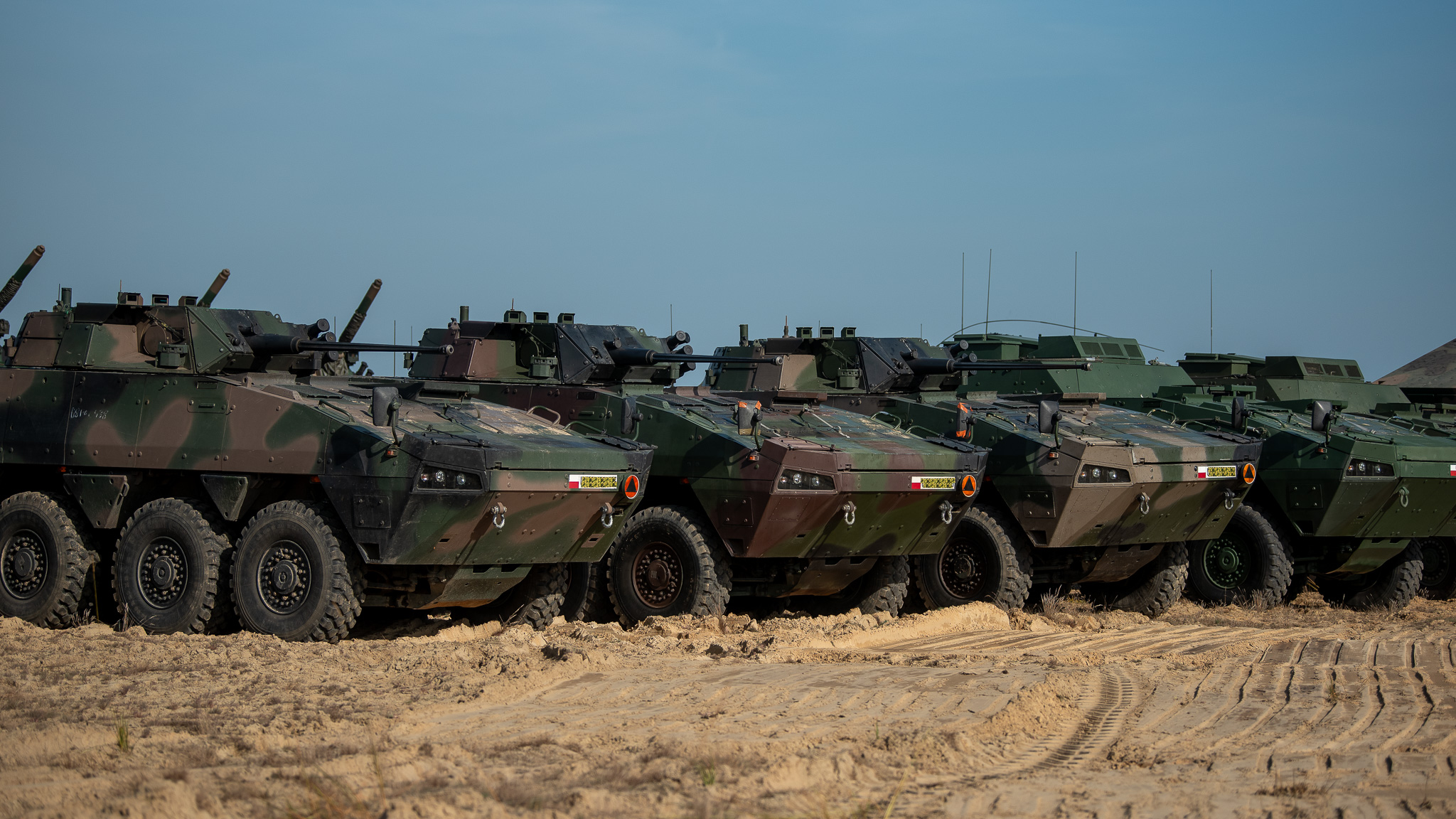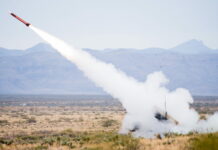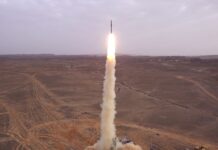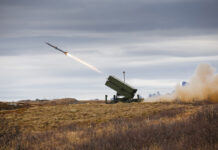The War in Ukraine has pushed Poland to significantly boost its military spending. This represents a substantial opportunity for the Polish defence industry, which is now operating at full capacity. The industry is also counting on new orders and investments.
The War in Ukraine, which escalated to the point of full-scale invasion in February 2022, poses a significant threat to NATO, especially to the countries of Central and Eastern Europe. Still, it also presents a major opportunity for defence industries, and Poland’s is no exception. In recent years, Warsaw has intensified its technical modernisation and increased its military spending. In 2024, defence expenditures are projected to reach a record EUR 37.6 billion (approximately 4.5% of GDP). Unfortunately, around 70% of this spending is on imported armaments.
Additionally, the war in Ukraine has provided a promotional opportunity for Polish armaments and the domestic defence industry. Poland has supplied Ukraine primarily with used equipment, including MiG-29 aircraft, T-72M1 tanks, BMP-1 infantry fighting vehicles (IFVs), and Mi-24 assault helicopters. However, the Ukrainians have also received equipment from the Polish defence industry, which has proven highly effective in combat. These include PT-91 Twardy tanks, previously considered somewhat outdated, but very useful in practice, as well as modern systems such as Krab 155 mm self-propelled howitzers (SPHs), MSBS Grot 5.56 mm assault rifles, and various drones, including Polish-made FlyEye surveillance/reconnaissance UAVs and Warmate loitering munitions. The Piorun man-portable air defence system (MANPADS) has also achieved particular renown in Ukraine, effectively countering Russian helicopter defensive countermeasure systems.

Credit: WB Group
Rising capacity
Many Polish factories have capitalised on the war in Ukraine to boost their production capacities. A notable example is the Łucznik factory in Radom, which designs and produces small arms, including the Grot assault rifle. The first batch of these rifles was delivered to Ukraine in March 2022. In the same year, the production of Grot rifles increased to 17,000 units, and in 2023, it increased to 35,000. By 2026, Łucznik aims to produce 100,000 rifles annually. The Polish Armed Forces alone have placed an order for 236,000 Grot rifles, with at least 80,000 already delivered. Simultaneously, work is underway on the Grot A3, which will compared to the previous variant will feature a shorter barrel and a more ergonomic design.
Poland’s Huta Stalowa Wola (HSW) is now doubling its production capacity; the company manufactures several leading systems, including the Baobab-K automated mine-laying vehicle, 120 mm Rak self-propelled mortar, the WR-40 Langusta 122 mm multiple rocket launcher (MRL), and most notably, the Krab 155 mm self-propelled howitzer. HSW has acquired new land and facilities, and is increasing its workforce. This expansion is largely due to the company receiving EUR 141 million in capital last year, with an additional EUR 282 million promised in the near future. These funds will also facilitate the modernisation and enhancement of production capabilities at HSW’s Autosan plant in Sanok, which produces both civilian and military vehicles.

Credit: Polish MoND
In 2023, PGZ’s Jelcz, known for its various trucks (4×4, 6×6, 8×8, 10×10), has also received additional funding. The company is now involved in several projects, including chassis (Jelcz 662D.43) for new naval missile units (MJR), wheeled MS-20 Daglezja-S bridgelayers (Jelcz C662D 6×6), and South Korean Chunmoo rocket launchers (Jelcz P882.57 TS T45).
Poland is also striving to rebuild its naval industry. Over the past 20 years, the Polish shipbuilding industry lost the capability to design and build modern ships, especially combat vessels. The first attempt to change this was the Gawron class corvette project (Project 621), based on the Meko A100 platform from Germany, but it was unsuccessful. A breakthrough occurred in 2013 with the signing of a contract to design and build the Project 258 Kormoran II mine hunter, which was fully designed in Poland. Three ships have already joined the Polish Navy, with another three under construction. This project demonstrated Poland’s potential to revive its shipbuilding capabilities.
Both Remontowa Shipbuilding and PGZ Stocznia Wojenna are currently involved in the construction of three next-generation multipurpose frigates from the Miecznik series. This project leverages foreign technology acquired from Babcock International Group (the Arrowhead 140 frigate design) and Thales UK (TACTICOS Combat Management System). The ships will be built in Polish shipyards with significant involvement from the Polish defence industry. In 2022, PGZ Stocznia Wojenna reported a profit of EUR 634,000. Although modest, it is noteworthy for two reasons. Firstly, it was the first profit in a long time and secondly, before its acquisition by PGZ in 2017, Stocznia Wojenna was on the brink of liquidation due to bankruptcy.

Credit: Polish MoND
Great hopes are pinned on the planned expansion of Nitro-Chem in Bydgoszcz, the largest producer of TNT and other high-energy materials in Europe. In 2023, Nitro-Chem began automating the filling of explosive materials and is systematically increasing its production capabilities. Currently, TNT is produced in three shifts, operating 24 hours a day. Due to its importance, Nitro-Chem, which produced 10,000 tonnes of TNT annually before Russia’s full-scale aggression against Ukraine in 2022, is now a highly protected company, including counterintelligence measures. Nitro-Chem is also active in exports, being the largest supplier of TNT to the US Army. Its current production capacities are classified.
Main challenges
The Polish defence industry continues to face significant challenges. Many issues stem from years of neglect, underfunding, and a lack of developmental vision. Currently, one of the key problems is the still relatively small contribution of the Polish defence industry to the technical modernisation of the armed forces. General Artur Kuptel, Chief of the Armament Agency, recently acknowledged that the goal is to place as many orders as possible with the Polish defence industry, but production capacities are currently being fully utilised. A prime example is the top product of the Polish defence sector, the Krab SPH. Ukraine has previously ordered 54 Krabs, and received an additional 54 as a donation. In 2024, under a commercial agreement, Poland is to deliver the third batch of 18 howitzers. This contract has completely exhausted HSW’s production capabilities, prompting Polish authorities to purchase Korean Hanwha K9 howitzers. The situation may improve in the near future, as HSW plans to build four new halls, doubling production, but this is a long-term process.
General Kuptel recently revealed that the Polish defence industry would like to receive additional funding of approximately EUR 3.3 billion. Deputy Prime Minister and Minister of National Defence Władysław Kosiniak-Kamysz added that the government’s ambition is to place 50% of orders with the Polish defence industry. Poland’s priority is not so much the ‘Polonisation of products as the ‘Polonisation’ of production.
Another issue is the limited innovation and few proprietary new technologies. So far, Poland has been better at modernising military equipment than creating it from scratch. Additionally, using acquired foreign know-how to create indigenous systems has been problematic. This is evident in the Rosomak 8×8 wheeled armoured personnel carrier project, which is both a success and a failure. On the one hand, it is an undeniable success for the Polish defence industry. The vehicle is a Polish domestic licence-produced version of Patria’s AMV design, and the rights to manufacture it were purchased from Patria in 2002.

Credit: Polish MoND
Since then, hundreds have entered service with the Polish Armed Forces. The Polish defence industry has successfully acquired foreign technology, created its own production lines, and delivered numerous variants. In the meantime, Polish experts have prepared hundreds of improvements and several specialised versions. The project provided development opportunities for entities such as HSW and WB Electronics. Unfortunately, the product failed to attract foreign customers for several reasons, including licencing restrictions and limited production capabilities. Nontheless, in July 2024, the Armament Agency ordered 58 Rosomaks with the new ZSSW-30 remote turret, which was locally designed.
Competition in international markets is fierce, and Polish companies often lack experience, courage, and sometimes even the will to compete; the latter is particularly true for state-owned enterprises where decision-makers are often politically appointed, whereas private firms tend to perform better. Consequently, international cooperation for Polish firms is typically one-sided — foreign companies enter the Polish market and establish business relationships. Even good and proven products such as the Rosomak and Krab struggle to find foreign customers. For example, while 40 Patria AMVs were produced for the UAE, this contract was awarded to Patria, not Rosomak S.A.
A significant weakness of the Polish defence industry is its continued reliance on assembling artillery ammunition from foreign-sourced components. This limits Polish companies to producing 30,000–40,000 artillery shells annually, while the Russian military consumes that amount in just a few days. In the face of a potential prolonged military conflict, this is a crucial issue, especially since Poland has already transferred most of its ammunition reserves to Ukraine. In December 2023, PGZ signed a contract for the production and delivery of 300,000 units of 155 mm artillery ammunition. The implementation is scheduled for 2024–2029, with an estimated value of EUR 2.6 billion. This contract is part of a plan that includes spending EUR 470 million to build production capacity and another EUR 2.8 billion to produce around 800,000 rounds.
According to Paweł Poncyljusz, CEO of Polska Amunicja, by 2028, Poland’s capacity to produce 155 mm ammunition will exceed 100,000 units annually. This will also mark the point where ammunition will be entirely produced in Poland without any licencing restrictions. A factory is planned to be built in Lower Silesia to achieve this goal. A major disappointment was the European Commission’s decision to allocate EUR 500 million to European defence companies to increase artillery ammunition production, with only one Polish company – Dezamet, part of the Polska Grupa Zbrojeniowa (PGZ; ENG: Polish Armaments Group) – receiving around EUR 2.1 million from this fund.
Poland also hopes to enhance its armoured vehicle industry, which has significantly shrunk since 1989 and is now primarily limited to offering repair services and minor upgrades. For instance, PGZ’s Bumar-Łabędy in Gliwice is involved in the modernisation of Leopard tanks under the Leopard 2PL project. Simultaneously, in February 2024, WZM (Wojskowe Zakłady Motoryzacyjne) in Poznań opened a service centre for M1 Abrams tanks, as Poland ordered 116 M1A1 FEP tanks (deliveries completed in June 2024) and 250 M1A2 SEPv3 tanks (deliveries due to be complete in 2025).

Credit: Polish MoND
A critical project for the industry is the acquisition of technology for the South Korean K2 tank, which is expected to be ‘Polonised’ as the K2PL variant. Negotiations with Seoul are ongoing, but it is already known that the maintenance and servicing of these tanks will be handled by WZM in Poznań. Regarding Leopard 2 tanks, PGZ aims to produce more spare parts, but the German manufacturer KNDS Deutschland has not agreed to this. In recent years, Poland obtained a licence to produce barrels for Leopard 2A4 and 2A5 tanks.
Poland is expected to acquire additional know-how through other projects, including Homar-K (Based on Hanwha’s K239 Chunmoo multi-calibre MRL) and Narew (a medium-range air defence system (MRAD) based on MBDA’s EMADS system, armed with CAMM-ER surface-to-air missiles (SAMs)). For the latter, the PGZ-Narew Consortium plans to produce over 1,000 CAMM-ER SAMs and 138 iLauncher transporter erector launchers (TELs) in Poland, sufficient to outfit 23 Narew batteries. The Narew system will also be equipped with locally-designed and produced P-18PL VHF radars for early-warning, considered a unique system within NATO, as it can not only detect low radar cross-section targets from a long distance, but also ballistic missiles.
Leading products
The dominant player in the Polish defence industry remains the state-owned PGZ, a holding company comprising 50 defence sector companies. PGZ offers a wide range of products, including ammunition, air defence systems, armoured vehicles (such as the wheeled Rosomak), optoelectronics, radars, and small arms. In 2023, PGZ’s revenues exceeded EUR 2.6 billion, a significant increase from less than EUR 940 million in 2015. The total value of PGZ’s contracts with units under the Ministry of National Defence (MON) exceeds EUR 3.3 billion. Another leading company is HSW. A notable private company excelling in international markets is WB Group, which offers Command, Control, Communications, Computers, and Intelligence (C4I) systems (FONET), fire control and battle management systems (Topaz), UAVs (FlyEye, FT5), and loitering munitions (Warmate), many of which have been sold abroad.

Credit: Polish MoND
Besides Nitro-Chem, PGZ’s Mesko from Skarżysko Kamienna is performing well in markets globally. The company produces the Grom/Piorun series MANPADS, which have been successfully used in Ukraine. The latest variant, Piorun, introduced into service in Poland in 2019, is an advanced version of the Grom system, itself a modification of the Soviet 9K38 Igla system. Mesko’s anti-aircraft system can engage targets at ranges up to 6.5 km and at altitudes up to 4 km. Currently, Mesko is working on a new version of Piorun. The Grom/Piorun series have been purchased by countries such as Estonia, Norway, Latvia, the United States, and Lithuania. There is also the Poprad, a mobile VSHORAD vehicle armed with Grom/Piorun, of which 79 units were delivered to the Polish military in 2020-2021, with this system now also offered to Portugal.
Belma, based in Bydgoszcz, has unveiled an upgraded version of the MPBK-ZN anti-armour roadside landmine. This mine is effective at ranges of 2–50 m and is equipped with a proximity fuse (acoustic and thermal). According to the producer, it can be used in urban areas, mountain passes, or conditions unsuitable for conventional anti-tank mines. The MPBK-ZN directs an explosively-formed penetrator (EFP) towards its target, intended to strike the side of a target vehicle, and capable of engaging a moving target. The EFP is capable of penetrating up to 100 mm of rolled homogenous armour equivalent (RHAe) at 50 m. The mine is resistant to countermeasures such as electromagnetic mine clearing, lightning discharges, and nearby explosions. Importantly, it can be easily deactivated and removed, and is now ready for production.

Credit: Polish MoND
Another significant project in the Polish defence industry is the Borsuk tracked IFV, equipped with a Mk 44S Bushmaster 30 mm automatic cannon and Rafael Spike-LR2 anti-tank guided missiles (ATGMs). The vehicle has completed the technical part of its qualification tests and is awaiting orders for serial production. A framework agreement signed last year plans for the acquisition of approximately 1,400 units, including over 1,000 in the IFV configuration. The Borsuk, with a combat weight of around 28 tonnes, can transport a crew of three and six dismounted soldiers. It was recently showcased at Eurosatory 2024, near Paris. Additionally, the Polish defence industry is developing a heavier IFV, which will be used alongside the Borsuk, based on the Hanwha K9 platform.
Robert Czulda




![Beyond the drone line: Lessons from the drone war in Ukraine A typical RF controlled FPV drone, shown during take-off. These little platforms have already reshaped the battlefield significantly, but in many ways have not yet reached their full potential. [Armyinform]](https://euro-sd.com/wp-content/uploads/2025/06/RF-FPV-Drone-Takeoff_Armyinform-Kopie2-218x150.jpg)




